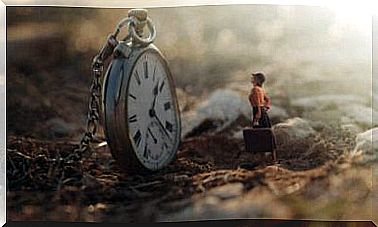People Who Do Not Say Much, How Are They?

Some people say very little. However, they are often good at listening and are able to offer their participation without having to say anything. Some say they are boring. They say they are too shy and spending time with them is a waste of time. However, people with few words often hide an incredible world behind the silence. Furthermore, they are usually extremely reliable.
An interesting anecdote about quiet people concerns Sir Alec Guinness, one of the best British actors of all time. In addition to mastering acting, he was known for varying the timbre and tone of voice in each role he took on. In fact, he was so chameleon-like that every time he received an award, like Oscar for his role in The Bridge over the Kwai , everyone wanted to hear what he had to say.
Many waited for a speech from him, to hear his true voice and finally get closer to the true person behind each of the characters he played. However, Guinness was always a man of few words. He received his awards after a short and anxious “thank you”. Then he disappeared immediately. Naturally, this perpetuated the mystery and fascination that surrounded him further.
In reality, not everyone who is known for their reserved nature, to speak only when necessary, hides a mental illness or antisocial behavior. In fact, this type of behavior represents only one more facet of the human personality. Moreover, such people are usually well-liked, and they build stronger and healthier social bonds.

People who do not say much
We call them “quiet”, “reserved” or “shy”. In fact, those who say little are quite rare in a world where those who talk a lot are usually seen as more successful, charismatic and attract more attention. In general, it seems that we like talkative people who talk. The people who in a very short time can tell you your life story as well as hundreds of anecdotes.
However, chatter can sometimes be exhausting. On the other hand, quiet people can be exciting. Still, it seems we are used to the idea that extroversion and words are synonymous with success. That those who master this competence also possess leadership qualities and are more confident.
But is this true? The truth is that this topic is as interesting as it is relevant. For example, in 2017, the University of Georgia (USA) conducted a study to examine the leadership style of extroverts and introverts.
One thing they discovered was that the most reserved people have other tools, skills and communication styles that are extremely useful in any kind of organization. There is another leadership style that is worth finding out more about.
Intimacy and reserved character
The vast majority who do not say much tend to be introverted. Jennifer B. Kahnweiler wrote a book entitled The Introverted Leader: Focusing on Your Quiet Strength. In this book, she explains how this personality style is increasingly coming to the fore. They are defined by the following features:
- They think before they speak.
- They know how to listen. In fact, they reflect on what they are being told and take longer to respond.
- They are observers. They are also imaginative and are great analysts of reality.
- They do not shy away from social contact. In fact, they are not shy at all. However, they are selective when it comes to building friendships.
- They like to be alone.
- They are careful. In fact, they take the greatest care of their relationships. Furthermore, they are reliable. For their part, they value having people with whom they can be confidential.
Shyness and people who do not say much
There are some people who do not say much because they are insecure. In these cases, they have shy personalities. But even if they do not feel particularly comfortable in a social environment, it does not mean that they end up failing either in their emotional or work environments.
We know that people like Jorge Luis Borges and Agatha Christie were incredibly shy. Furthermore, Sir Alec Guinness and actor Dick Bogarde used to throw up before going on stage. But once they got into their roles, they performed them masterfully. It seems that while it is true that personal shyness limits and hurts, at the same time it is often counteracted by the emergence of great virtues.

The reflective personality: inner peace in a busy world
In a world where people exchange ideas, opinions and thoughts without almost any filters, people who do not say much have a completely different rhythm. Therefore, we must take another factor into account. This is the reflective approach.
They are the ones who always think about what to say before they say it. They listen with all their senses before responding. They also take their time. This is because their communication is always genuine. They speak honestly in accordance with their faith. They are always observant of the surroundings. Furthermore, they are empathetic, intuitive and able to perceive how others are and what they need.
All this requires a calmer approach. In fact, these people let others speak first and always listen, pay attention and study what is being said… Only then do they speak loudly, hoping to be both helpful and respectful in what they say. Their way of acting, processing information and mastering requires more time. This means that they may not be as fluent in communication.
To many, this trait may seem unusual. However, there is only one other facet of personality. Furthermore, we are all unique and not everyone has the ability to speak “straight from the liver”. If we understand this, we will be better able to understand the behavior of others who are not necessarily always like us.









